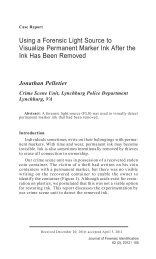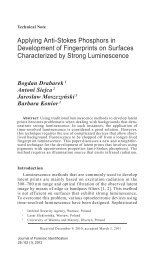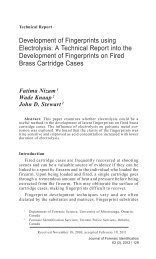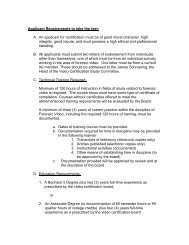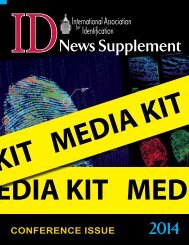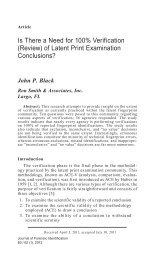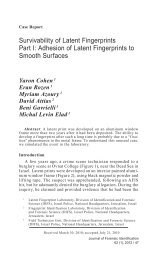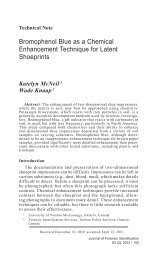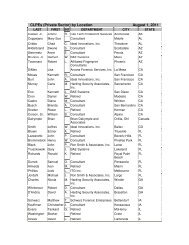Individualization Using Friction Skin Impressions: Scientifically ...
Individualization Using Friction Skin Impressions: Scientifically ...
Individualization Using Friction Skin Impressions: Scientifically ...
You also want an ePaper? Increase the reach of your titles
YUMPU automatically turns print PDFs into web optimized ePapers that Google loves.
in the not-distant future, persons as closely related as brothers<br />
will be routinely distinguished, and DNA profiles will be as<br />
fully accepted as fingerprints now are.” [3] General acceptance<br />
is found not only in the scientific community [2, 3, 43], but it<br />
has also been found in the legal arena from 1911 until the present<br />
day [4, 5, 38, 40-42, 44-50].<br />
Conclusion<br />
This paper reviewed some long-held challenges to the science<br />
of friction ridge skin examination argued by some of the most<br />
well-known critics of the discipline. The primary focus of their<br />
arguments is that friction ridge skin cannot be reliably individualized<br />
to a single source to the exclusion of all others. Their<br />
arguments are supported by claims that the uniqueness of friction<br />
ridge skin has not been proven, and, if proven, is metaphysical<br />
and cannot be detected by the examiner to reliably apply the<br />
science. The critics assert that the science is not reliable and<br />
therefore is not legally valid. Furthermore, the critics attempt<br />
to exclude the application of the science of friction ridge skin<br />
examination from American courtrooms by suggesting its legal<br />
inadmissibility according to the Federal Rules of Evidence 702,<br />
which codified Daubert, that the science has not been tested and<br />
validated, has not been subjected to peer review and publication,<br />
does not have a known or predictive rate of error, and is not<br />
generally accepted by the relative scientific community.<br />
This paper, however, demonstrates the flawed logic on which<br />
these claims rest. By arguing against the scientific reliability of<br />
friction ridge skin examination and claiming that the uniqueness<br />
of friction ridge skin has not been proven, and if proven, could not<br />
be detected, these critics are ignoring the theory and experience<br />
that have risen from the observations that occurred beginning<br />
in the late 17th century and subsequent medical research that<br />
has been performed since the early 1900s through present day.<br />
These critics are also ignoring the multiple probabilistic models<br />
that have been developed since 1892, the mass of empirical data<br />
that has accumulated since 1860 when friction ridge skin was<br />
first systematically used for the purpose of personal identification,<br />
and the billions of comparisons conducted through AFIS<br />
databases all over the world since the late 1970s and early 1980s<br />
when the AFIS technology was first introduced.<br />
By arguing that the science of friction ridge skin examination<br />
is not legally valid and is inadmissible under the Federal Rules<br />
of Evidence 702, as codified by Daubert, the critics are failing<br />
Journal of Forensic Identification<br />
74 / 62 (1), 2012



